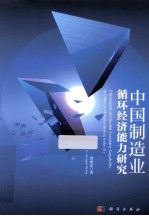

中国制造业循环经济能力研究PDF电子书下载
- 电子书积分:12 积分如何计算积分?
- 作 者:黄承雷著
- 出 版 社:北京:科学出版社
- 出版年份:2014
- ISBN:9787030405128
- 页数:340 页
中文篇 3
第1章 绪论 3
1.1 研究背景 3
1.2 研究问题 4
1.3 研究目标 5
1.4 研究贡献 5
第2章 理论框架和假设 7
2.1 理论基础 7
2.1.1 复杂理论 7
2.1.2 自然资源基础理论 7
2.1.3 吸收能力理论 8
2.1.4 动态能力理论 8
2.1.5 生态现代化理论 9
2.1.6 理论整合 9
2.2 理论模型 10
2.3 构念和次构念的构建和定义 11
2.3.1 外部环境的环保动态特性 11
2.3.2 环保导向 14
2.3.3 潜在吸收能力 15
2.3.4 产品监管 16
2.3.5 绿色供应链设计 18
2.3.6 循环经济能力 21
2.3.7 环保绩效 23
2.3.8 商业绩效 25
2.4 假设构建 26
2.4.1 假设1:外部环境的环保动态特性对于环保导向的影响 26
2.4.2 假设2:环保导向对于产品监管和绿色供应链设计的影响 27
2.4.3 假设3:潜在吸收能力对产品监管和绿色供应链设计的影响 28
2.4.4 假设4:产品监管对绿色供应链的影响 29
2.4.5 假设5:产品监管和绿色供应链设计对于循环经济能力的影响 29
2.4.6 假设6:循环经济能力对于环保绩效和商业绩效的影响 30
2.4.7 假设7:环保绩效对商业绩效的影响 31
第3章 测量工具建立 32
3.1 测量项目生成 32
3.2 预测试和结构化采访 32
3.3 Q-sort先导性测试 32
3.3.1 Q-sort先导性测试结果评价 33
3.3.2 Q-sort先导性测试结果 34
3.4 调查问卷的编写和翻译 38
第4章 数据采集与分析 39
4.1 数据采集 39
4.1.1 大规模问卷调查 39
4.1.2 数据采集过程 39
4.1.3 调查样本特点 40
4.1.4 样本整合性测试 52
4.1.5 不回应偏见检测 55
4.2 测量工具的验证方法 58
4.2.1 结构方程模型原理 58
4.2.2 测量方式 60
4.2.3 评价指标 61
4.2.4 测量模型 63
4.3 测量模型的分析与结果 64
4.3.1 影响因素相关构念的测试 64
4.3.2 建立机制相关构念的测试 80
4.3.3 成果绩效相关构念的测试 91
4.3.4 整体模型分析 103
4.3.5 共同方法变化检测 107
第5章 结构模型的分析与结果 114
5.1 结构模型 114
5.2 数据分析方法 114
5.2.1 PLS建模 114
5.2.2 PLS的评价方法 115
5.3 结构模型的分析结果 115
5.3.1 PLS建模过程 115
5.3.2 “外部”测量模型的分析结果 115
5.3.3 “内部”结构模型的分析结果 117
5.3.4 自展法稳定性测试 119
5.3.5 共同方法偏差检测 123
5.4 假设讨论 125
第6章 应用、局限、后续研究和结论 130
6.1 应用 130
6.1.1 在学术研究中的应用 130
6.1.2 在经营实践中的应用 131
6.1.3 在中国制造业中的应用 132
6.2 局限 133
6.3 后续研究 134
6.4 结论 135
附录A 初始测量项目和参考文献 136
附录B 中文版调查问卷 141
English Part 153
Chapter 1 Introduction 153
1.1 Background 153
1.2 Problem Statement 154
1.3 Research Objective 155
1.4 Research Contribution 156
Chapter 2 Theoretical Framework and Hypotheses 158
2.1 Theoretical foundation 158
2.1.1 Complexity Theory 158
2.1.2 Natural Resource Based View(NRBV) 159
2.1.3 Absorptive Capacity Theory 159
2.1.4 Dynamic Capability Theory 160
2.1.5 Ecological Modernization Theory 160
2.1.6 Theory Integration 161
2.2 Theoretical Model 162
2.3 Constructs/Sub-Constructs Development and Definition 164
2.3.1 Business Contextual Dynamism for Environmental Implementation 165
2.3.2 Environmental Orientation 168
2.3.3 Potential Absorptive Capacity 169
2.3.4 Product Stewardship 172
2.3.5 Green Supply Chain Design 175
2.3.6 Circular Economy Capability 179
2.3.7 Environmental Performance 181
2.3.8 Business Performance 183
2.4 Hypothesis Development 185
2.4.1 Hypothesis 1:The Impact of Business Contextual Dynamism for Environmental Implementation on Environmental Orientation 187
2.4.2 Hypothesis 2:The Impact of Environmental Orientation on Product Stewardship and Green Supply Chain Design 187
2.4.3 Hypothesis 3:The Impact of Potential Absorptive Capacity on Product Stewardship and Green Supply Chain Design 189
2.4.4 Hypothesis 4:The Impact of Product Stewardship on Green Supply Chain Design 190
2.4.5 Hypothesis 5:The Impact of Product Stewardship and Green Supply Chain Design on Circular Economy Capability 191
2.4.6 Hypothesis 6:The Impact of Circular Economy Capability on Environmental and Business Performance 192
2.4.7 Hypothesis 7:The Impact of Environmental Performance on Business Performance 193
Chapter 3 Instrument Development 195
3.1 Item Generation 195
3.2 Pre-test and Structured Interview 195
3.3 Pilot Study Using Q-sort 196
3.3.1 Assessment of Q-sort Results 196
3.3.2 Results of Q-sort Pilot Study 197
3.4 Questionnaire Development and Translation 202
Chapter 4 Data Collection and Analysis 203
4.1 Data Collection 203
4.1.1 Review of the Survey Method 203
4.1.2 Data Collection Procedure 204
4.1.3 Characteristics of the Respondent Sample 205
4.1.4 Sample Aggregation Tests 217
4.1.5 Non-response Bias Tests 220
4.2 Instrument Validation Methodology 224
4.2.1 Structural Equation Modeling(SEM) 224
4.2.2 Measurement Approach 226
4.2.3 Assessment Indexes 228
4.2.4 Measurement Model 230
4.3 Measurement Model Analysis and Results 231
4.3.1 Antecedent Constructs Validation 231
4.3.2 Mechanism Constructs Validation 247
4.3.3 Outcome Constructs Validation 260
4.3.4 Overall Model Analysis 274
4.3.5 Common Method Variance Assessment 278
Chapter 5 Structural Model Analysis and Results 285
5.1 Structural Model 285
5.2 Data Analysis Method 285
5.2.1 PLS Modeling 286
5.2.2 Methods of Assessing a PLS model 286
5.3 Results of Structural Model Analysis 287
5.3.1 Review of PLS Modeling Procedure 287
5.3.2 Results of The "Outer" Measurement Model 287
5.3.3 Results of the "Inner" Structural Model 288
5.3.4 Assessment of Stability of Bootstrapping Procedure 291
5.3.5 Common Method Bias Test 295
5.4 Discussion of Hypotheses 296
Chapter 6 Implications,Limitations,Future Research and Conclusion 304
6.1 Implications 304
6.1.1 Implications for Researchers 304
6.1.2 Implications for Practitioners 306
6.1.3 Implications for the Chinese Manufacturing Industry 308
6.2 Limitations 310
6.3 Future Research 311
6.4 Conclusion 312
Appendix A Initial Measurement Items and References 314
Appendix B English Version of the Questionnaire 319
References 329
- 《红色旅游的社会效应研究》吴春焕著 2019
- 《汉语词汇知识与习得研究》邢红兵主编 2019
- 《生物质甘油共气化制氢基础研究》赵丽霞 2019
- 《东北民歌文化研究及艺术探析》(中国)杨清波 2019
- 《联吡啶基钌光敏染料的结构与性能的理论研究》李明霞 2019
- 《异质性条件下技术创新最优市场结构研究 以中国高技术产业为例》千慧雄 2019
- 《中国制造业绿色供应链发展研究报告》中国电子信息产业发展研究院 2019
- 《《国语》和《战国策》词汇比较研究》陈长书著 2017
- 《中央财政支持提升专业服务产业发展能力项目水利工程专业课程建设成果 设施农业工程技术》赵英编 2018
- 《行政保留研究》门中敬著 2019
- 《指向核心素养 北京十一学校名师教学设计 英语 七年级 上 配人教版》周志英总主编 2019
- 《《走近科学》精选丛书 中国UFO悬案调查》郭之文 2019
- 《北京生态环境保护》《北京环境保护丛书》编委会编著 2018
- 《中医骨伤科学》赵文海,张俐,温建民著 2017
- 《美国小学分级阅读 二级D 地球科学&物质科学》本书编委会 2016
- 《指向核心素养 北京十一学校名师教学设计 英语 九年级 上 配人教版》周志英总主编 2019
- 《强磁场下的基础科学问题》中国科学院编 2020
- 《小牛顿科学故事馆 进化论的故事》小牛顿科学教育公司编辑团队 2018
- 《小牛顿科学故事馆 医学的故事》小牛顿科学教育公司编辑团队 2018
- 《高等院校旅游专业系列教材 旅游企业岗位培训系列教材 新编北京导游英语》杨昆,鄢莉,谭明华 2019
